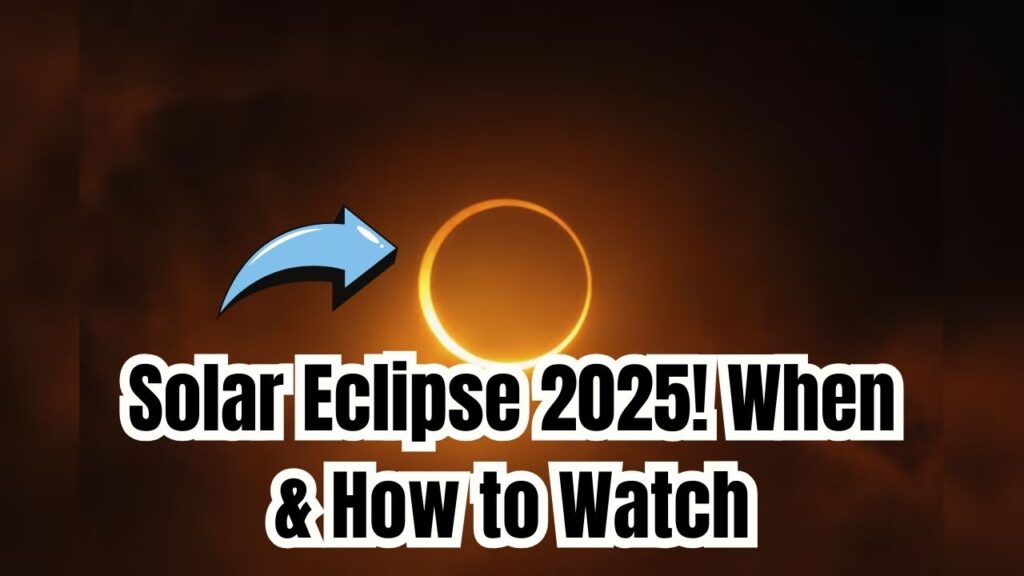
Solar Eclipse 2025: A partial solar eclipse is set to grace our skies on March 29, 2025—an extraordinary celestial event where the Moon will partially block the Sun, creating a surreal dance of light and shadow. Whether you’re a casual skywatcher or a professional astronomer, the Solar Eclipse 2025 offers a rare opportunity to connect with the cosmos.
From safety tips to best viewing locations, this guide has everything you need to prepare, watch, and enjoy the eclipse safely and meaningfully.
Solar Eclipse 2025
| Topic | Details |
|---|---|
| Event Date | March 29, 2025 |
| Eclipse Type | Partial Solar Eclipse |
| Maximum Obscuration | Up to 93% in parts of northern Quebec, Canada |
| Global Visibility | North America, Greenland, Europe, Northwest Africa, Russia |
| Eclipse Duration | ~2 Hours |
| Timing (UTC) | Starts: 8:50 AM • Peak: 10:48 AM • Ends: 12:43 PM |
| Viewing Tools Needed | Eclipse Glasses, Solar Filters, Pinhole Projectors |
| Live Stream Option | NASA Eclipse Live |
The Solar Eclipse 2025 on March 29 is not just a visual treat, but an educational, cultural, and scientific opportunity. Whether you’re gazing up from Canada, streaming it online from Africa, or teaching kids about space, this guide gives you the tools to safely and fully enjoy the moment.
What Is a Solar Eclipse? (Simple Explanation)
A solar eclipse happens when the Moon moves between the Earth and the Sun, casting a shadow on Earth and partially or fully blocking the Sun’s light. During a partial eclipse, the Moon covers only a portion of the Sun, making it appear as though a bite has been taken out.
Fun fact: Solar eclipses happen 2 to 5 times a year, but they’re only visible from limited locations on Earth!
Visibility Map and Global Coverage
The Solar Eclipse 2025 will be visible in the following regions:
- 🇨🇦 Canada (Northern Quebec, Newfoundland)
- 🇺🇸 Eastern United States
- 🇬🇱 Greenland
- 🇫🇷 France
- 🇪🇸 Spain
- 🇷🇺 Northwestern Russia
- 🇲🇦 Morocco
- 🇮🇸 Iceland
Eclipse Timetable (UTC)
| Phase | Time (UTC) |
|---|---|
| Eclipse Begins | 8:50 AM |
| Maximum Eclipse | 10:48 AM |
| Eclipse Ends | 12:43 PM |
Use a local time converter to adjust for your time zone.
How to Watch the Eclipse Safely
Your eyes are precious—never look directly at the Sun without protection.
Safe Viewing Methods:
- Eclipse Glasses: Must meet ISO 12312-2 certification.
- Solar Filters: For telescopes, binoculars, or cameras.
- Pinhole Projector: Create your own indirect viewer using two pieces of paper.
- Online Viewing: Watch live via NASA’s Eclipse Broadcast.
Avoid using sunglasses, homemade filters, or unverified glasses.
Eclipse Day Checklist
- Confirm your location and weather.
- Pack your eclipse glasses or pinhole projector.
- Bring a blanket or chair to sit comfortably.
- Set alarms for all eclipse phases.
- Charge your devices or cameras.
- Share the experience with friends or kids!
Scientific & Cultural Significance
Eclipses have inspired wonder and fear for millennia. In ancient China, they were seen as dragons eating the Sun. Indigenous cultures viewed them as spiritual events.
In STEM education:
- Used to teach orbital mechanics, shadow geometry, and solar physics.
- Great opportunity for student experiments on temperature, light, and behavior during the eclipse.
NASA’s Education Portal has resources for teachers and students.
Applications for Professionals
- Astronomers: Use eclipses to study the Sun’s corona and magnetic field.
- Meteorologists: Monitor sudden drops in temperature and light.
- Photographers: Capture rare high-contrast images of the eclipse.
- Educators: Turn this into a teachable moment!
Frequently Asked Questions (FAQs)
1. Will the eclipse be visible in India or Australia?
No, this eclipse is not visible in India, China, Southeast Asia, or Australia.
2. What should I avoid during the eclipse?
- Avoid looking directly at the Sun.
- Avoid using telescopes or binoculars without solar filters.
3. Can I photograph the eclipse?
Yes, but only with a solar filter on your lens. Use a tripod for best results.
4. Is it safe to be outside during a solar eclipse?
Absolutely! Just ensure you don’t look at the Sun without proper eye protection.







